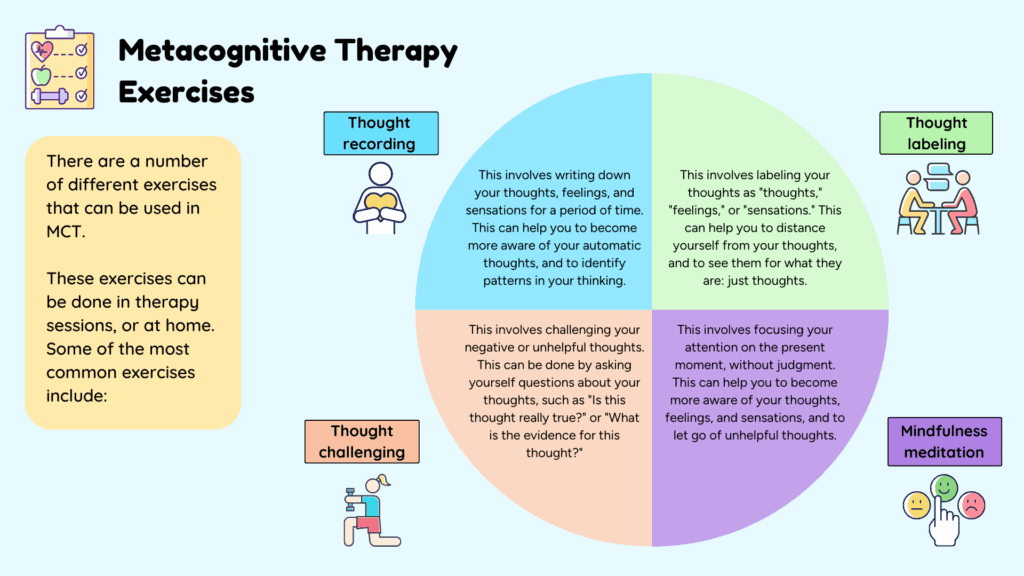Meta-cognitive therapy is an emerging therapeutic model that is based on the theory of metacognition. Metacognition can be described as a higher-order cognitive process that involves thinking about thinking. In other words, when you become aware of your cognitive functions, such as memory retrieval, information processing, thoughts, beliefs, etc., and try to process them, it is a form of metacognition – you engage in metacognitive strategies whenever you have an inner dialogue about your thought processes.
In this article, we look at metacognitive therapy with a couple of easy-to-understand examples.
What Is Metacognitive Therapy?
Metacognitive therapy helps clients understand their cognitive processes, understand the intricacies, and act on what is essential for better therapeutic outcomes. It is a more robust and advanced form of cognitive therapy, which includes self-awareness, awareness of mental processes among those around us, and gaining insight into our psychological complexities. Metacognitive therapy makes use of three essential strategies, which include planning, monitoring, and evaluation.
- The first step is to plan our outcomes and list our strengths and weaknesses.
- The second step is to monitor our thinking and other internal cognitive processes. A lot of reflection is involved here, which helps improve our decision-making, insight formation, and self-understanding.
- Finally, one learns to evaluate different cognitive processes and try to form the bigger picture to synthesize disparate beliefs, thoughts, and emotions.
In short, metacognitive therapy helps people learn to reflect and gain insight into their cognitive processes. During therapy sessions, a metacognitive therapist helps clients give meaning to these emerging understandings while ensuring that self-reflection remains at the heart of all therapeutic work.
Metacognitive Therapy Techniques
Metacognitive therapy helps you deal with your distressing thoughts and experiences so that you do not have to spend much time worrying about them. It enables you to connect with your inner cognitive processes and allows you to observe them in a non-judgmental manner. It can be used to treat multiple mental health issues such as personality disorders, anxiety, depression, and post-traumatic stress disorder, among many other conditions.
One of the most influential proponents of metacognitive therapy is Professor Adrian Wells, who believes worrying and rumination interfere with our recovery process. Hence, the crux of metacognitive therapy is to help patients reduce their rumination and worrying tendencies.
Here are some important techniques of metacognition therapy:
- Reducing Cognitive Attentional Syndrome (CAS): CAS is a pattern of responses to automatic negative thoughts rooted in suppressing, escaping, or giving into them helplessly. The therapist helps the client to attend to these negative thinking patterns by teaching them how to deal with automatic negative thoughts.
- Activating Metacognitive Control System (MCS): MCS holds all our metacognitive knowledge and helps us recognize when we are ruminating about problems and worrisome situations. The therapist teaches the client to activate MCS and keep ruminations at bay.
- Taking control of the Cognitive System (CS): Metacognitive therapists believe that the Cognitive System acts like our mind’s supervisor and influences our thoughts, acts, and feelings. Hence, the therapist teaches metacognitive strategies that can effectively influence our cognitive system. Think about it as if it were a “how-to-think” guide.
- Metacognitive beliefs: These are beliefs about our cognitive processes that we think will help us. They can be either positive or negative. Positive metacognitive beliefs urge us to linger around negative thoughts and feelings without trying to escape them. Negative metacognitive beliefs predispose one to think that specific thoughts and feelings are harmful. This causes us to suppress or escape them, which leads to mental health issues.
Metacognitive Therapy Exercises

Find a therapist via BetterHelp
Metacognitive Therapy Examples
1. A person with anxiety may have a negative metacognitive belief and a poor control of the Cognitive System. He may believe: “I must not worry as it will make me anxious.” His Cognitive System may urge him to think, “If I worry, I will lose control and experience a panic attack.”
The therapist’s goal is to change the negative metacognitive beliefs and replace them with something helpful, such as” “It is probably OK to worry and tolerate distress” and “If I worry, it does not mean I will lose control. I probably will not have a panic attack“.
2. A person with depression may have a negative metacognitive belief that goes something like this: “I am sad all the time, and hence my mood will never improve.” His Cognitive System may further reinforce these beliefs: “I am always sad, and hence nothing about my mood will ever improve.”
The therapist, in this case, helps the client to recognize cognitive distortions that maintain negative metacognitive beliefs and helps the client to replace them with something more in line with reality: “I may be sad, but there are moments when I am not sad” and “As there are brief periods of clarity and joy, there is a possibility that I can expect these positive feelings to recur.”
Metacognitive Therapy vs Cognitive Behavior therapy
| Metacognitive Therapy | Cognitive Behavior therapy |
| Focuses on metacognition, thinking about thinking | Focuses on cognitions, beliefs about the world, and changing certain behaviors. |
| Thoughts are not as important as certain metacognitive beliefs | Places more importance on changing thoughts |
| Takes an indirect approach toward solving problems | Adopts a more directive approach to solving problems |
| Exposure to unpleasant situations is urged to change metacognitive beliefs | Exposure to unpleasant situations is encouraged to reduce anxiety |
Metacognitive Therapy vs Other Therapy Options
It is challenging to compare metacognitive therapy with other therapeutic modalities such as behavior therapy, psychodynamic therapy, or dialectical behavior therapy. It is important to remember that a trained therapist often considers different therapeutic modalities as tools in a box. Depending on your suitability and the condition for which you seek therapy, your therapist may choose one or more of the therapeutic modalities he/she is trained in. However, we can confirm that metacognitive therapy is an evidence-based approach to help people deal with various psychological conditions.
If you need therapy and wonder if metacognitive therapy is the right option, speak to a psychotherapist near you. You may receive metacognitive therapy based on your presenting complaints and the therapist’s skillsets. Your therapist may also encourage you to try other therapeutic modalities if they think you will benefit.





